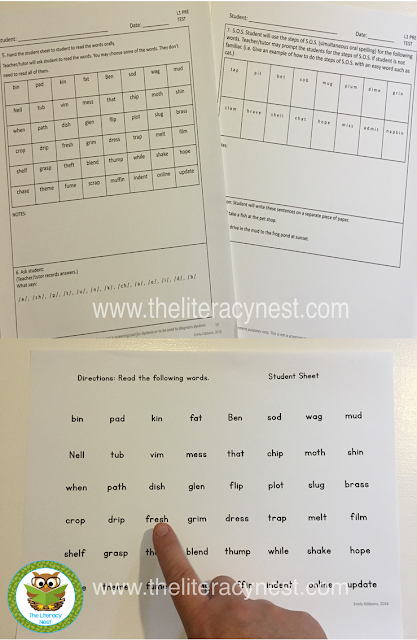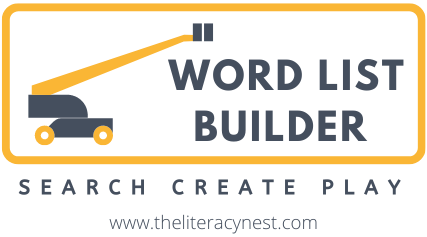Progress Monitoring Tips for Your Orton-Gillingham Lessons
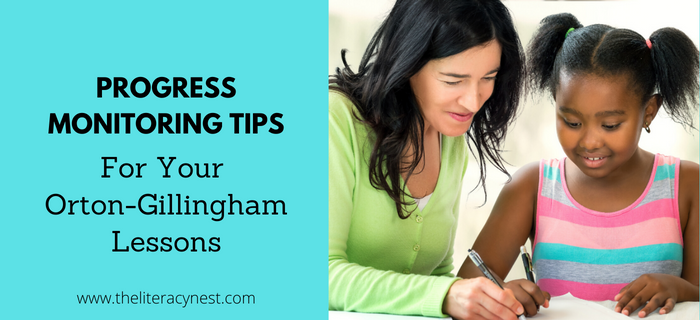
Want to learn how to monitor your Orton-Gillingham lessons? Here are some useful tips. The data-driven world of education can sometimes feel overwhelming. But with the tips I have for progress monitoring, the task isn’t going to feel so daunting.
Is it important for you to take some time to consider progress monitoring? Yes!
- If you are an Orton-Gillingham teacher working in a school, you may be looking for progressing monitoring tools to reflect your instruction and student learning.
- If you are an Orton-Gillingham tutor in private practice, you may be looking for ways to share progress with schools, parents, or even at IEP meetings. While you aren’t required to adhere to a particular progress monitoring schedule, it’s a good idea to do some formal progress monitoring periodically.
When considering progress monitoring there are two main questions for you to ask:
- How often are you going to progress monitor your student?
- What tools should you use to progress monitor?
Frequency and Schedule
It is important to always have a baseline assessment. This way, you have something to compare to to see and evaluate student growth. Depending on your student’s level and placement in the Orton Gillingham sequence, and the tools you decide on using, this may include assessments you administer when first starting with a student or additional assessments looking at specific skill areas.
The frequency is dependent on three factors:
- your student
- where you are currently in your currently with lesson planning
- the tools you choose
You may wish to do progress monitoring monthly, quarterly, or midway through a level of your Orton-Gillingham sequence. It is also advisable to administer an assessment at the end of a level. ensures mastery and targets any areas for reteaching and review. The nature of systematic sequential instruction and the repetitions needed by the learner with dyslexia may require different scheduling than some other students.
General measures of growth, such as fluency passages, are frequently not sensitive enough to show the student’s steady growth when assessed weekly.
Your students need meaningful time to review what you have previously taught based on their individual needs. Read Meaningful Review in Orton-Gillingham Lessons.
The difficulty of “doing” progress monitoring:
One of the difficulties many instructors find with “doing” progress monitoring arises because the principles of Orton-Gillingham instruction require the teacher to be prescriptive and diagnostic. While this may not create tidy fluency graphs with a nice mathematical slope, this constant analysis and reflection is a form of progress monitoring and an important principle of effective structured language instruction.
Learn more about what it means to be prescriptive and diagnostic. Watch my video, What does it Mean to be Diagnostic and Prescriptive?
Whenever you execute a lesson, you are progress monitoring in small doses. Keeping careful notes and utilizing a checklist on student performance will help you not only to prepare for subsequent lessons requiring reteaching or review but also make this information easier to share with colleagues, parents, and classroom teachers.
What Informal Assessment Tools for Progress Monitoring Should You Use?
(The links to Amazon below are affiliate links.)
It is important to be mindful of your selection of progress monitoring tools and the schedule you choose. It may be more helpful to give a more time-consuming assessment quarterly than to administer a fast assessment more frequently that isn’t measuring the focus of your instruction.
If you are required to use certain progress monitoring tools and schedules per your school district, you may wish to consider using additional measures that are more sensitive to the instruction you are providing.
Download a printable PDF of this list for your files: Informal Assessment Tools for Progress Monitoring in OG Lessons.
1. Screeners from Really Great Reading
Really Great Reading has a variety of nice, complimentary screening tools. They cover beginning and advanced decoding, phonemic awareness, and letter knowledge. These are available online at Really Great Reading. They are designed to be administered three times a year with parallel forms of equal difficulty. In addition, they have a progressing monitoring tool. This tool was specifically designed for their phonics programs that provide pre and post-tests for each of their phonics lessons.
2. Words Their Way Spelling Inventory
The Words Their Way spelling Inventory is a quick-to-administer developmental spelling test. It measures a student’s application of specific patterns and features. For even greater sensitivity, the Ganske DSA: Developmental Spelling Analysis further breaks down the broad spelling stages into features. With a quick spelling test, much information can be gained about a child’s encoding progress. With two separate forms alternated, this is designed to be given at the beginning of the year and the conclusion of each 9-week grading period.
3. Gallistel-Ellis
This affordable and thorough decoding and encoding survey takes approximately 30 minutes to administer and aligns nicely with the Orton-Gillingham sequence. In my experience, students show gains that match the skills that have been taught, and this is an excellent way of demonstrating the step-by-step progress of the early stages of Orton-Gillingham instruction.
4. Core Assessment Tools
The book, Assessing Reading: Multiple Measures, has a wide variety of literacy assessments. This enables instructors to monitor very specific areas of literacy such as particular Phonemic awareness skills, fluency, phonics, and vocabulary. These assessments are designed to be given three times per year to inform instruction in addition to continual teacher observation.
5. Acadience Reading (Formally DIBELS Next)
When you hear the words progress monitoring, perhaps one of the first things to come to mind is DIBELS. Acadience DIBELS is the latest version of this assessment battery. Acadience includes both benchmark and progress monitoring assessments for reading fluency as well as letter naming fluency, nonsense word fluency, and sound fluency. It also has a data management system.
6. QRI
The Quality Reading Inventory (QRI-6) is an informal reading inventory that assesses text reading, comprehension, and fluency. This represents an overall picture of how student reading is progressing. It is best for periodic assessments rather than frequent monitoring. It can give a snapshot of a student’s “reading level”.
7. PAST Assessment
There are a number of phonemic awareness assessments out there. One of the best for monitoring the development and automaticity of advanced phonological awareness skills is the PAST by Dr. David Kilpatrick. There are multiple forms and giving this assessment each quarter or trimester can demonstrate how a student’s mastery and automaticity with phonological awareness skills have responded to teacher instruction. To read more about the PAST, see the book Equipped for Reading Success.
8. On Track Assessments by The Literacy Nest
Using an assessment that is closely aligned with instruction will be the most sensitive to show student growth. Using the pre and post-tests from The Literacy Nest can help you more accurately target instruction and assess a student’s mastery of OG concepts before exiting a level. Administering this assessment halfway through an Orton-Gillingham level can be valuable not only for demonstrating growth but for retargeting instruction to account for areas of weakness and new knowledge that may have been learned in other settings.
Taking a Closer Look at Spelling Errors: How a Spelling Assessment Can Inform Your Instruction.
Read a more detailed explanation of how to use this assessment in How To Find A Starting Point In Orton-Gillingham.
While there is no shortage of possible assessment tools, care should be given to be mindful when you choose an assessment and a schedule. Assessment should be worthwhile and informative.
A Final Progress Monitoring Tip…
It is helpful to keep a student binder or notebook. It provides an excellent overview of their progress and is a helpful way to show parents their student’s gains during conferences. Students are also frequently motivated by looking back at their own progress and seeing how much they have grown. Our students with dyslexia work so hard, they may lose track of how far they have already come.
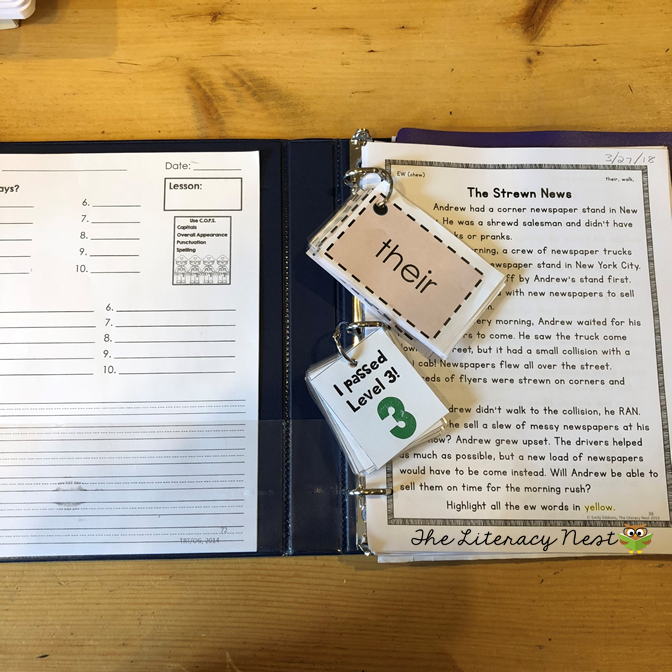
Once you have your data collection system in place, this will help you to continue being prescriptive and diagnostic. Read, What Does An Orton-Gillingham Lesson Look Like? for lots of tips.
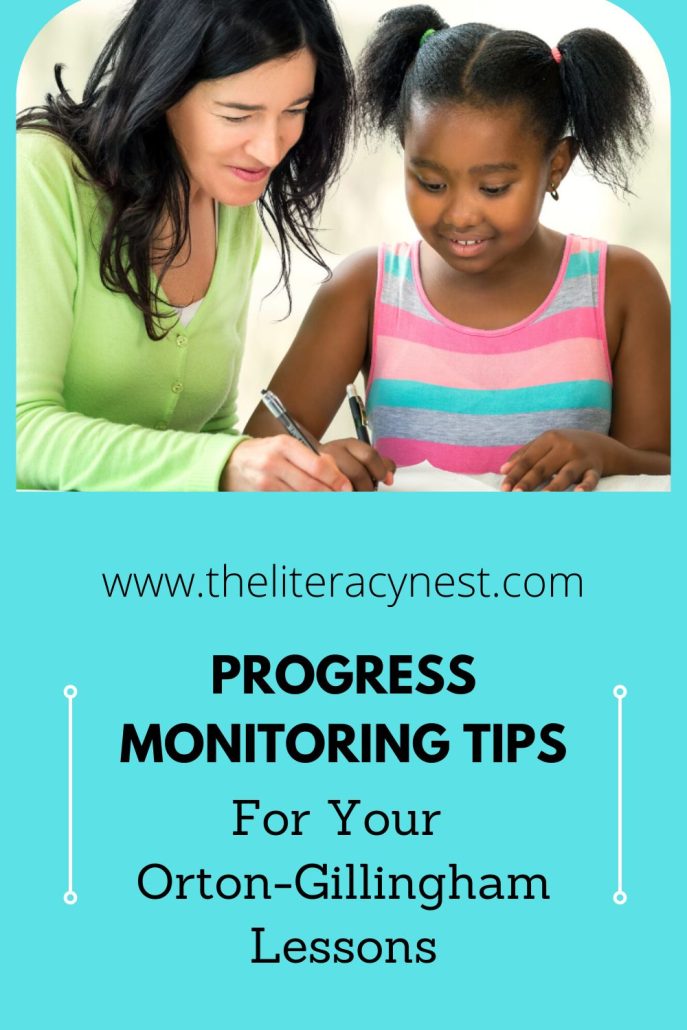
Have you tried Word List Builder for your Orton-Gillingham Lesson Planning?
Save time making customized phonics and spelling resources for your Orton-Gillinghma lessons! Build your folder of words and create templates in Word List Builder.

